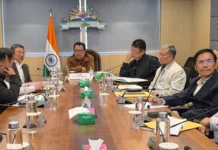[ Wangbo Wangsu George ]
Arunachal Pradesh, our vibrant ‘Land of Dawn-lit Mountains’, is celebrated for its unparalleled diversity. It is a state where the rich tapestry of biodiversity is mirrored only by the astonishing mosaic of its human inhabitants. With 26 major tribes and over 100 sub-tribes, we embody a living heritage of unique traditions, languages, and profound spiritual worldviews.
This intrinsic heterogeneity is not merely a characteristic; it is the very essence of our identity. It is precisely from this deep respect for our inherent pluralism that we must critically examine the evolving socio-religious landscape, particularly the rising discourse surrounding Donyi-Poloism. The recent elevation of Donyi-Poloism, culminating in high-profile endorsements such as the naming of our first major airport, has ignited a crucial, albeit uncomfortable, dialogue across the length and breadth of our state. While some hail this as a triumphant resurgence of indigenous faith, for many others, it provokes urgent questions about identity, genuine representation, and the very future of our collective cultural ethos. Are we truly witnessing an organic, unfiltered revival of native beliefs, or are we instead treading a path towards a state-sanctioned homogenization that risks eclipsing the countless other, equally authentic, Arunachali traditions?
To grapple with this question with the honesty it deserves, with much respect, we must first distinguish between Donyi-Poloism in its pristine, ancient form and its modern, institutionalized manifestation. At its core, the reverence for donyi(the sun) and polo (the moon) as cosmic witnesses and physical expressions of a supreme, formless creator is an age-old spiritual philosophy. For millennia, this has been the traditional faith system of the Tani-speaking peoples (Adi, Apatani, Galo, Nyishi, Tagin, etc). This original Donyi-Polo faith was deeply knotted with the rhythms of nature, guided by community ethics, and sustained by ancestral wisdom, passed down meticulously through the rich oral traditions of the nyibus (priests). In this unadulterated form, it stands as an undeniable, vital pillar of Arunachal’s spiritual heritage.
However, the Donyi-Poloism at the forefront of today’s debate is significantly a construct of a 20th-century revivalist movement. Sparked in the 1960s by the pressures of modernity and the proselytization efforts of other religions, visionary indigenous leaders, notably Talom Rukbo, embarked on a concerted effort to codify, institutionalize, and unify these traditional beliefs. This led to the formal establishment of organizations like the Donyi-Polo Yelam Kebang in 1986, the construction of dedicated places of worship known as ganggings, the transcription of sacred texts agoms, and the formalization of prayers and rituals.
While the impulse to preserve ancestral heritage is understandable and even laudable, the methods of this formalization and its subsequent political patronage raise serious concerns. A growing body of scholarship and observation points to a significant adoption of religious rituals and structures arguably foreign to the indigenous Donyi-Polo faith. The establishment of temple-like ganggings that mimic conventional temple architecture, the introduction of congregational worship styles, and the articulation of a philosophical framework with certain Vedantic or Puranic principles are merely a profound religious syncretism. This process has led to pointed accusations of a creeping ‘saffronisation’ of what was originally a distinct animist-shamanistic belief system. Leading scholars of Northeastern identity, such as Udayon Misra in his India’s Northeast: Identity Movements, State and Civil Society (2014),and others in their extensive analyses of regional socio-religious dynamics have meticulously documented that these revivalists have often turned away from the very indigenous originality of the tradition, introducing elements that fundamentally alter its core character. The apprehension is palpable: in its attempt to ‘save’ itself, Donyi-Poloism risks being reshaped into a convenient regional component of a larger, national religious identity, thereby subtly but irrevocably eroding its unique cosmological foundations.
This brings us to the most contentious point: the pervasive role of the state’s mechanism. The decision to name the Hollongi airport the Donyi Polo Airport was a watershed moment, presenting a symbolic gesture for some, but a deep affront to others. For the government and its proponents, it was an honouring of indigenous culture. But for a vast majority of Arunachal’s tribes, the critical question arises: which indigenous culture is being honoured? What message does such singular patronage convey to the Monpas and Sherdukpens of West Kameng and Tawang, whose societies have been shaped for centuries by a rich tradition of Tibetan Buddhism? What about the Noctes of Tirap, with their distinct indigenous belief in Jauban? What of the Wanchos, whose traditional system revolves around Jovan-Rang? And the Mishmi tribes (Idu, Digaru, Miju), the Tangsas, the Singphos with their unique Theravada Buddhist heritage, or the lots of other groups whose spiritual lives are entirely independent of the Donyi-Polo dyad?
By unilaterally elevating one specific tribal faith system to the level of state symbol, the government, whether by design or oversight, inadvertently establishes a hierarchy. It implicitly declares a ‘first among equals’, positioning the faith of the Tani groups as the default indigenous identity of Arunachal Pradesh. This is a profound misrepresentation of our state’s complex reality. The notion that Donyi-Poloism can serve as a ‘catch-all’term for all of Arunachal’s non-Abrahamic, non-Dharmic indigenous faiths is a historically tenuous and recently propagated proposition. It represents an attempt to stretch a specific cultural concept to encompass a diverse reality it was never intended to describe. The distinct cosmology of the Hruso (Aka) tribe, the spiritual practices of the Bugun (Khowa), or the ancestral worship of the Lisu are not mere branches of Donyi-Poloism; they are unique, self-contained systems. To subsume them under a single, newly institutionalized banner is to systematically erase their distinctiveness.
This leads us to the uncomfortable yet necessary question that shadows these developments: are there ‘shady principles of religious demography’ at play? While we must exercise caution with such charged terminology, it is the fundamental duty of a free press to scrutinize the political undercurrents of such pivotal decisions. In the current national climate of heightened religious polarization, the conspicuous promotion of a specific, increasingly ‘Sanskritized’ tribal faith can plausibly be interpreted as a strategic political manoeuvre. It could be viewed as an effort to consolidate an indigenous bloc that is ideologically aligned with a broader nationalist narrative, thus serving as a cultural bulwark against the influence of other religions, particularly Christianity. This is not mere conjecture; it is an analysis supported by numerous reports from credible institutions like the Centre for Policy Research, which have examined religious dynamics and cultural assimilation strategies in border states, as well as by independent academic research on the socio-political landscape of Northeast India.
The people of Arunachal have an undeniable right to question whether their rich, diverse cultural identity is being genuinely nurtured for its own intrinsic value, or if it is being instrumentalized as part of a larger political project.
So, how do we navigate this complex terrain? The solution is not to disparage Donyi-Poloism or the sincere faith of its adherents; it is a legitimate and cherished spiritual path for a significant portion of our populace. The path forward lies in fundamentally challenging the notion of its state-backed supremacy and re-evaluating the government’s role in overtly promoting one faith over others. First, there must be a profound and honest introspection within the leadership of the Donyi-Polo revivalist movement itself. They must ensure that in their earnest quest for institutional survival and recognition, they do not inadvertently sacrifice the very diversity they claim to represent. Syncretism, if it is to occur, must emerge as a conscious, organic choice of the people, not as a top-down imposition that blurs and erases distinct identities. Second, and critically, both the state government and the Government of India must unequivocally adopt a policy of equitable respect for all of Arunachal’s indigenous faiths. If a public institution is to be named, why not select a designation that truly resonates universally across our diverse populace? A name that speaks to our shared geography, our common history, or our collective aspirations – perhaps ‘Udayachal’, or after a unifying historical figure whose legacy transcends tribal affiliations. A state that genuinely champions pluralism cannot, under any circumstances, afford to be seen playing favourites with faith.
The enduring soul of Arunachal resides in its glorious multiplicity. We are a symphony composed of many distinct instruments, each playing its unique tune, rather than a singular solo performance. To amplify one instrument at the expense of all others is to inevitably destroy the harmony of the entire orchestra. The ongoing debate is a crucial test of our collective maturity as a state. We must navigate it not with acrimony or division, but with an unwavering commitment to the foundational principle that every tribe, every faith, and every ancestor holds an equal and honoured place in the Land of the Rising Sun. The delicate, precious fabric of our identity hinges on this commitment. (The contributor is Vice Principal, Don Bosco School, Longding. The views expressed are personal.)



